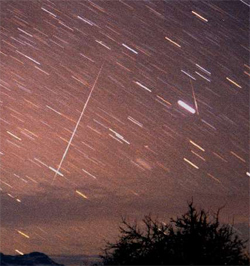 Not all light passing in front of our beloved stars and deep-sky objects is bad. Sometimes cosmic dust motes enter our atmosphere, super-heat, and create streaks called meteors. And the more, the merrier. When lots of streaks come from the same point in the sky, astronomers call the event a meteor shower.
Not all light passing in front of our beloved stars and deep-sky objects is bad. Sometimes cosmic dust motes enter our atmosphere, super-heat, and create streaks called meteors. And the more, the merrier. When lots of streaks come from the same point in the sky, astronomers call the event a meteor shower.
Amateur astronomers observe lots of meteor showers. This type of observing is easy: You don't need any special equipment; it's cheap; it's fun, and, if the sky's clear, it's rewarding.
Still, I can't count the times when I was observing a meteor shower and heard, "I wish we'd see a bright one." I may have just the shower for you.
Friday night and Saturday morning, December 14/15, mark the peak of the annual Geminid meteor shower. The Moon, a waxing crescent, won't be an issue. It sets before 10 P.M. local time. Several hours earlier, just after sunset, the shower's radiant (the point from which all the meteors seem to originate) rises along with its parent constellation, Gemini the Twins. The radiant lies near Castor (Alpha [α] Geminorum).
It's unusual for a shower's radiant to rise so early in the evening, but it's a good thing. By midnight, the radiant reaches its highest point in the sky. That's when you'll see the maximum number of meteors from any shower. For the Geminids, that number peaks at about 2 meteors per minute — that's a lot.
So, look for Geminids all night long. And here's a tidbit not many observers realize. Because of the shower's orientation in space, Geminid meteors have to catch up to Earth. This slows the meteors' trip through the atmosphere. Indeed, of all major meteor showers, the Geminids move the slowest. Their average speeds clock in at slightly less than 80,000 mph.
The longest trails generally appear during evening and morning twilight. The radiant's position near the horizon creates the right geometry for observers to see longer streaks at these times.
All meteor showers originate from comets — almost. The Geminids owe their particles to the asteroid 3200 Phaethon. This object orbits the Sun in a highly elliptical 1.4-year orbit that brings it within 0.15 AU of the Sun. One astronomical unit is the average distance between Earth and the Sun. It equals roughly 93 million miles. 3200 Phaeton made its closest recent approach to Earth in December 1997, when it passed within 0.31 AU of our planet. Here's another tidbit: When Phaethon is closest to the Sun, its surface heats up to 2,000° F.
Because of the composition of Phaethon, all Geminid meteors appear yellowish. And their greater density — the particles are twice as dense as "normal" meteoroids that come from comets — helps them survive longer in our atmosphere. That means longer streaks.
The Geminids are a reliable shower, and this is a good year for them. Take a blanket, and leave your sunglasses at home. This is light pollution we can all enjoy.